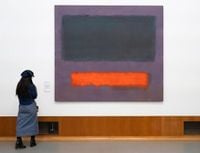On April 25, 2025, an unfortunate incident occurred at the Boijmans Van Beuningen Museum in Rotterdam, Netherlands, when a child damaged a valuable painting by renowned American abstract artist Mark Rothko. The artwork, titled "Grey, Orange on Maroon No. 8," is estimated to be worth up to 50 million euros (approximately 8.1 billion yen). This incident transpired during a "moment of inattention" as the child was exploring the museum.
According to a spokesperson for the museum, the damage is described as "superficial," with a "small mark visible on the paint layer at the bottom of the painting where the varnish is not applied." The museum is currently seeking opinions from conservation experts both within the Netherlands and internationally, as they explore the next steps for restoring the painting. The museum remains optimistic about the future, stating that they hope to exhibit the work again.
The damaged Rothko painting was displayed in the "Depot," a storage facility adjacent to the museum that is open to the public. This exhibition was part of a showcase featuring "generally popular" works from the museum's collection. Sophie Makariou, head of conservation at Fine Art Restoration Company, noted that modern paintings like Rothko's, which lack a protective varnish, are particularly vulnerable to damage. She explained, "The use of complex modern materials and the absence of traditional coating layers mean that even small damage is easily noticeable, and that damage to the top paint layer can significantly impact the viewing experience of the work."
Makariou further elaborated on the technique used by Rothko, known as Color Field Painting, which involves arranging large, flat blocks of color across the canvas. Joni Helme, marketing manager at art restoration service Plowden & Smith, echoed her sentiments, stating that the mixture of pigments, resins, and adhesives employed by Rothko is "extremely complex," making restoration a challenging endeavor. The absence of varnish, which leaves the painting exposed to environmental factors, adds another layer of difficulty for restorers.
Experts involved in the restoration process are currently documenting the extent of the damage and researching "successful past methods of restoring" Rothko's paintings. Helme remarked, "Rothko's works seem to have bad luck. I have heard of Rothko paintings being damaged in the past." In fact, Rothko's 1958 work "Black on Maroon" was intentionally damaged in October 2012 by Wlodzimierz Umaniec at Tate Modern in London. Umaniec was sentenced to two years in prison and later expressed remorse for his actions. During his trial, prosecutor Gregor McKindley revealed that the restoration of the work cost approximately 200,000 pounds and took 18 months to complete.
Regarding the financial implications of the damage, Rachael Martell from insurance company Aon stated that art insurance policies typically cover all risks related to the physical loss or damage of the artwork, including accidental damage caused by children or visitors, although there are specific exclusions. When damage occurs, the gallery's insurance company dispatches a specialist loss adjuster to assess the situation. Martell explained that the adjuster usually inspects the damage, reviews CCTV footage to determine the cause, and evaluates conservation options.
As of now, the Boijmans Van Beuningen Museum has not commented on who will bear the responsibility for the damage. "Grey, Orange on Maroon No. 8" was created in 1960 and is believed to have been purchased by the gallery in the 1970s. The museum has a history of charging visitors for damage caused to exhibited artwork. For instance, in 2011, a tourist who inadvertently stepped on Wim T. Schippers' artwork "Peanut Carpet," which involved spreading peanut butter on the floor, was asked to cover the restoration costs. Sharon Coen, then a spokesperson for the museum, mentioned that "it is standard procedure to pay when artwork is damaged," according to local media reports.
The incident in Rotterdam is not isolated, as there have been numerous cases of modern art being damaged in the Netherlands in recent years. In November of the previous year, a robbery attempt at an art gallery in Oisterwijk resulted in damage to several screen prints by Andy Warhol. Additionally, a municipality in the Netherlands admitted that it may have mistakenly disposed of 46 works of art during renovation work last year, which included a print of the former Queen of the Netherlands by Warhol.
Museums and galleries have varying policies regarding damage caused by children. For example, in August of last year, a 4-year-old boy accidentally broke a 3,500-year-old jug on display at the Hecht Museum in Israel. Lihi Raz-Lehman, a staff member at the museum, stated that they would not take strict action because "the jug was accidentally damaged by a young child." Following the incident, the family was invited back to the exhibition and participated in a tour.
This recent event at the Boijmans Van Beuningen Museum raises important questions about the protection and preservation of valuable artworks, as well as the responsibilities of both museums and visitors in safeguarding these cultural treasures. As the museum navigates the restoration process for Rothko's painting, it serves as a reminder of the delicate nature of modern art and the unforeseen challenges that can arise in public spaces.





